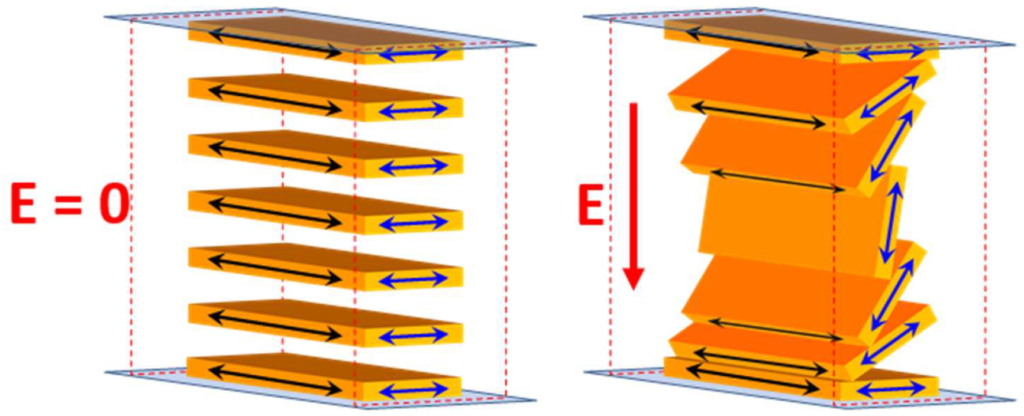Liquid-crystal (LC) displays exploit a physical phenomenon called the Fréedericksz transition. This effect is only observed with “nematic” LCs which are fluids of rod-like molecules aligned in the same direction. The Fréedericksz transition consists in the reorientation of this direction by an electric field. There is however another large class of LCs, called “smectics”, where the molecules are not only all aligned but they also form equidistant layers. Smectics do not show the Fréedericksz transition because the reorientation would disturb the lamellar structure. Consequently, smectics are not used in display technology up to now.
Usual LC molecules have a rod-like cylindrical shape and they are all aligned in the same direction, called the “n-director”, in the nematic LC phase. Moreover, they also spontaneously form layers in smectic LC phases which can be regarded as 1-dimensional stacks of fluid layers. In search for new display mechanisms, scientists have recently considered exotic molecular shapes, such as banana-like or board-like ones that strongly differ from the usual rod-like cylindrical shape. These molecules are “biaxial”, meaning that they lack revolution symmetry. Then, they can form biaxial smectics, labelled “SmAb”, where not only their longest axis is aligned along the n-director, but also their medium one, along the so-called “m-director”.
During the electro-optic investigation of these compounds, an international team coordinated by scientists from Laboratoire de Physique des Solides discovered that the SmAb phase displays an effect highly reminiscent of the Fréedericksz transition of nematics (Figure 1). Using polarized-light microscopy, birefringence and dielectric measurements, they showed that it is a Fréedericksz transition affecting the m-director (Figure 2). This biaxial Fréedericksz transition is actually possible in a biaxial smectic because it does not alter the n-director field and therefore the lamellar structure is preserved. Moreover, they found that the relaxation time of this effect is much shorter than that of the usual Fréedericksz transition of nematics, so that the biaxial SmAb phase could be exploited in electro-optic devices that require fast switching.

Figure 1. (left) Domains (size » 100 µm) of smectic phase (red) in a nematic cell (orange). (right) When an electric field is applied, the birefringence of the smectic domains changes. This induces a red-to-green transition and the appearance of twin domains separated by walls (black lines).

Figure 2. (left) The biaxial LC molecules have a board-like shape, with their longest dimension defining the layer thickness (delimited by the red dotted lines) of the smectic phase. (right) Upon application of an electric field E, the boards rotate, which changes the apparent birefringence of the material, just like the usual Fréedericksz transition, but does not affect the smectic layers. (The black (resp. blue) double-headed arrows represent the n-director (resp. the m-director).
Reference
Fréedericksz-Like Transition in a Biaxial Smectic-A Phase
C. Meyer, P. Davidson, D. Constantin, V.i Sergan, D. Stoenescu, A. Knežević, I. Dokli, A. Lesac, I. Dozov
Phys. Rev. X, 2021, 11, 031012
doi: 10.1103/PhysRevX.11.031012
Contacts
Patrick Davidson
Ivan Dozov
